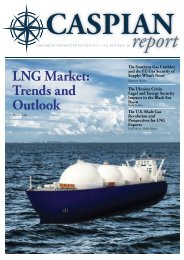Caspian Report - Issue: 07 - Spring 2014
You also want an ePaper? Increase the reach of your titles
YUMPU automatically turns print PDFs into web optimized ePapers that Google loves.
On April 17 th <strong>2014</strong>, the TAP consortium<br />
handed an updated, 1,200 page version<br />
of the Environmental and Social Impact<br />
Assessment of the Italian section of<br />
the TAP project, as required by Italian<br />
authorities.<br />
Italy is probably the most difficult<br />
place on earth to build new industrial<br />
infrastructures, at least judging<br />
from the troubles encountered by<br />
any proposed energy project over<br />
the last several decades. In Italy almost<br />
all new producing plants or infrastructures<br />
are likely to face some<br />
opposition, and this is even more so<br />
for projects involving energy. Things<br />
are especially difficult in some areas,<br />
notably southern regions like Apulia,<br />
where TAP should come ashore.<br />
In order to get an idea of the highly<br />
complex environment faced by companies,<br />
it is helpful to begin with a<br />
brief summary of the lengthy and<br />
tortuous permissions process. Let’s<br />
start with the endpoint: on April 17 th<br />
<strong>2014</strong>, the TAP consortium handed<br />
the Italian Ministry of Environment<br />
(MATTM) and the Italian Ministry of<br />
Cultural Heritage (MINBAC) an updated,<br />
1,200 page version of the Environmental<br />
and Social Impact Assessment<br />
of the Italian section of the TAP<br />
project, as required by Italian authorities.<br />
After evaluating 12 alternative<br />
routes for the pipeline, as requested<br />
by MATTM and MINBAC in March,<br />
the document confirms that the<br />
one coming ashore near San Foca is<br />
the best solution in environmental,<br />
technical and socio-economic terms.<br />
The TAP consortium restated that<br />
the pipeline will be ready for operation<br />
in 2019.<br />
This was the last step in a very complex<br />
path towards attaining the<br />
relevant environmental authorisations<br />
for the project, as the 5.6 GB<br />
of publically available documents<br />
produced by the consortium stand<br />
to testify. The Environmental Impact<br />
Assessment (EIA) is a technical-administrative<br />
procedure that,<br />
according to Legislative Decree no.<br />
152/2006, is normally carried out<br />
by an ad hoc decision making process<br />
by competent agencies (Conferenza<br />
dei Servizi). The Conferenza<br />
dei Servizi review the decisions of<br />
all governmental agencies involved<br />
in the EIA procedure, including central<br />
and local governments. This<br />
type of coordination is designed to<br />
guarantee that all stakeholder interests<br />
are taken into consideration,<br />
while enabling the EIA to comply<br />
with its schedule, which should not<br />
exceed 150 days.<br />
For the TAP, as for any natural gas<br />
pipeline of that relevance, Legislative<br />
Decree no. 152/2006 requires an<br />
EIA procedure, in order to carefully<br />
47<br />
CASPIAN REPORT, SPRING <strong>2014</strong>










